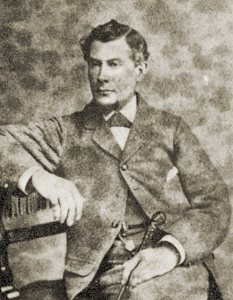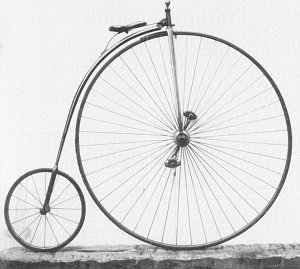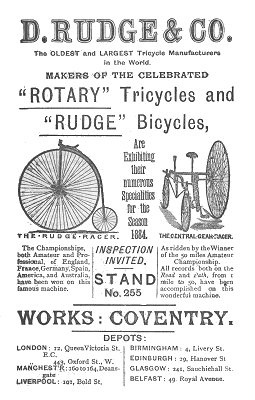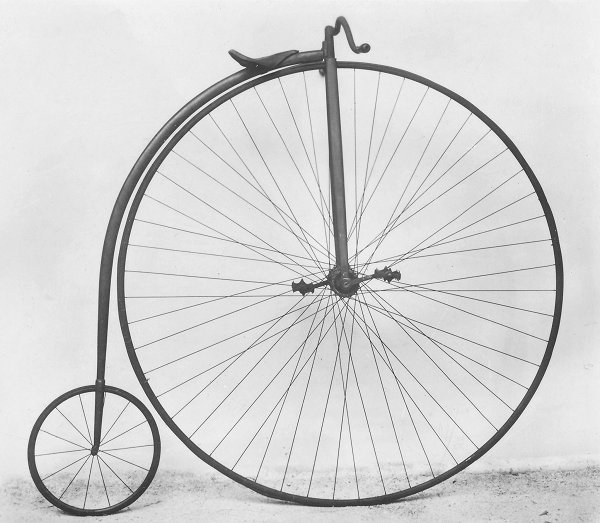Rudge Cycles
| We have to thank Derek Beddows for the following
article about Dan Rudge.
Daniel Rudge 1841 -
1880
Daniel Rudge was born in January
1841. The Wolverhampton Census for 1841 lists Daniel Rudge as
living with his family at Wharf Street, Wolverhampton. After
serving with the 38th Regiment of Foot he returned to
Wolverhampton and opened a public house called the Tiger Inn in
Church Street near to St John’s Church. At the same time an army
colleague Henry Clarke started a wheel building business called
the Temple Street Wheel Works. |

Dan Rudge. Photo courtesy of Peter Hällström. |
In 1865 Daniel married
Mary Ann Clift at Darlington Street Methodist Church. They were to
have three children, Miriam, Harry George and Frederick.
Rudge a skilled engineer became
interested in bicycles through his friend Walter Phillips who
rode bicycles and Henry Clarke who in 1868 began the Cogent
Cycle Company.
In 1869 Walter Phillips and George
Price became interested in the new cycle industry. Price was
primarily interested in the business end of cycle manufacture,
whereas Phillips was interested in the actual making of cycles.
The two realised that to successfully manufacture cycles they
would need a skilled engineer to design and sort out any
mechanical problems. |
| Daniel Rudge was
approached about manufacturing a velocipede designed by Phillips. A
deal was struck and Rudge was soon producing cycles in a small
workshop located at the rear of the Tiger Inn, with Henry Clarke
supplying the wheels.
By the end of 1874 Daniel Rudge
had manufactured a small number of high bicycles. His first
machines were nothing out of the ordinary as they ran on regular
plain bearings.
Around this time a Frenchman who
had met Henry Clarke during his army service called on him
riding a French velocipede. Both Daniel Rudge and Henry Clarke
were taken on how the French velocipede ran with ease. They
determined to find out the mechanical advantage of the French
machine. It is said that that they got the Frenchman drunk. Then
dismantled his machine to find that it ran on ball bearings
instead of the more traditional plain bearings common on the
cycles of the day. |
| By 1878 Rudge had
established as a manufacturer of High quality bicycles. Never
satisfied with other makers’ designs and construction Rudge invented
numerous innovations. In 1878 Rudge took out British Patent No 526
for his adjustable ball bearings. These bearings were fitted to his
high bicycles and improved their efficiency. Rudge cycles soon
gained a reputation for fast starts and thus became extremely
popular. Rudge machines were often handicapped 20 or 30yards behind
other racers. Because of this publicity the demand for Rudge cycles
increased.
Daniel Rudge visited the famous
French cyclist Terront in his London hotel while on a visit to
England. Rudge proceeded to demonstrate to Terront a set of his
patent adjustable ball bearings. Terront was impressed enough to
purchase a racing machine built by Rudge. |

The only surviving example of a Daniel Rudge
ordinary. It can be found in the First Penny Farthing Museum, rear
of 92 King Street, Knutsford. This photo is by courtesy of the
curator, Glynn Stockdale (who sponsored the plaque to Daniel Rudge
on the Telecom Building in Church Street). |

This advert is from the programme for the
1884 Wolverhampton Art and Industry Exhibition. At this time
manufacture had moved to Coventry. The illustrations give an idea of
how the original Rudge cycles must have looked. |
Daniel Rudge also
travelled to Paris and Lyons to observe the French cycling scene and
to take part in some of the races.
The added company responsibility,
the company now based in nearby Bishop Street employed 100
employees by 1878 and various other cycle activities had a
detrimental effect on Rudge’s health
In the early summer of 1880 Daniel
Rudge fell ill for the last time. He died at a hospital for the
terminally ill at 1 Cumberland Terrace, Ealing, London on 26th
June 1880 of cancer at the age of 39.
The sales of Rudge cycles remained
excellent for several months after his death, but with nobody to
run the company the company seemed doomed. Rudge’s widow Mary
with the assistance of Walter Phillips arranged the sale of the
Rudge cycle concern to George Woodcock of Coventry. The sale
arrangement included a cash sum plus a regular pension for Mary
Rudge. In exchange Woodcock acquired the famous adjustable ball
bearing patent 526 and the services of some of Rudge’s former
employees. |
| Woodcock took the
cycle company and merged it with The Tangent & Coventry Tricycle
Company and formed D. Rudge & Co based in Coventry.
D.W. Beddows
For a short while in the late 1870's Dan was producing Humber
bicycles. Humber went into partnership with Marriott and Cooper
in 1877. The partnership soon ended, and Marriott and Cooper
left Humber and started to manufacture and sell Humber bicycles.
The bicycles were made by Dan Rudge and sold using the Humber
name. The Humber company itself started to sell its machines as
'Genuine Humbers' to distinguish them from the other variety.
Dan exhibited a machine at the 1878 London Cycle Show, the first
that was organised by the Stanley Bicycle Club. The machine was so
well received that he won a gold medal for its excellence. The
machine featured his patented Rudge bearings and ball pedals, which
he invented. He also became well known because Charles Terront, a
famous rider, used Rudge axles. Dan's eldest son Harry later joined forces with a Mr.
Wedge to form the cycle making company Rudge Wedge with premises in
Pelham Street and later Mander Street.
|
|

|
|
Read the Rudge Family
History |
The following brief article on Dan Rudge was kindly supplied by Ray
Miller of the Veteran-Cycle Club:
"Daniel Rudge had been the landlord of the ‘Tiger’s Head’ public house
in Wolverhampton. His close friend was Henry Clarke, who started a
wagon wheel building business and then ran the Cogent Cycle Co.
Daniel was interested in racing, and with Henry's help he began to build
his own racing machines at 19 Church Street, Wolverhampton, which
included an improved form of wheel bearing. Many people wanted his
bicycles, and in 1870 he started building and selling racing machines.
He made many improvements to his bicycles and they soon became the best
racing machines that were available at the time.
He started to take part in the races that were held in the grounds of
the Molineux Hotel, Wolverhampton. He won the very first cycle
race to be held there in 1869, and was very successful. He started
producing high wheelers in 1874 and, for a short while in the late
1870's, Dan was producing Humber bicycles for Marriott and Cooper after
they had parted company with Humber,
although they had the use of the name. In 1878 he was awarded a
gold medal for his exhibit at the London Cycle Show. Dan Rudge
died on 26 June 1880, having formed the Rudge business, and his widow
continued to run it until November 1880 when it was sold to George
Woodcock and amalgamated with the bankrupt business of Haynes & Jefferis
to form the Tangent and Coventry
Tricycle Company.

A Rudge ordinary from an old postcard.
Woodcock had also purchased the assets of the collapsed Haynes &
Jefferis firm in 1879 and relocated the combined business to Ariel
Works, Trafalgar Street, Coventry in 1880 having taken over the business
of the Tangent and Coventry Tricycle Company. In 1885 the business
was transferred into a private limited company called D. Rudge & Co.
Ltd. It became the Rudge Cycle
Co Ltd, Coventry, on 21 October, 1887, a public company with capital of
£200,000. Walter Philips was the renowned works manager and
Lawson, H. J., the sales manager. Stoddard & Lovering of Boston,
Mass. were the US agents.
Maker of the ‘Ariel’, ‘Emperor’, ‘Mechanic’s’, ‘Rudge’ ‘Swiftsure’
and ‘Tangent’ high wheelers. The ‘No.2 Ordinary’ was one of the
best known competitive machines of its era which pioneered adjustable
ball races on wheels and pedals. Other competitive features
pioneered by the company were hollow backbones and lighter tangentially
spoked wheels.
Although Rudge took over manufacture of the ‘Coventry Rotary’ from
Starley & Sutton from 1885, the name ‘Coventry Rotary’ was retained
through to 1892 in Rudge catalogues, when production ceased. The
‘Triplet Tandem Quadricycle Direct Steering Roadster’ was produced from
1888.
The ‘Royal Crescent’ tricycle was made for about three years from
1886. It was introduced in Roadster, Ladies and Racer forms.
Also the ‘Royal Crescent’ tandem tricycle. A ‘Parcels Carrier’ and
‘Parcels Express’ were made before 1892 as well as the ‘Roadsculler’ and
‘Triplet’. The Rudge cross-frame safety was patented in 1887 and
sold as the ‘Rocket’. By 1889 the company was making safety
bicycles with diamond pattern frames but with halved tubes for lightness
named the ‘Bicyclette’. The company produced the ‘Déesse’ brand
for sale in France. In 1894 it built the ‘Giraffe’ safety, along
with Starley, J. K. & Co., under licence from Humber & Co. Ltd.
In May 1891 George Woodcock died. This coincided with a
reduction in trade. The company was rescued by the Whitworth Cycle Co.
in 1894 to form Rudge Whitworth Ltd."
Ray Miller
|



